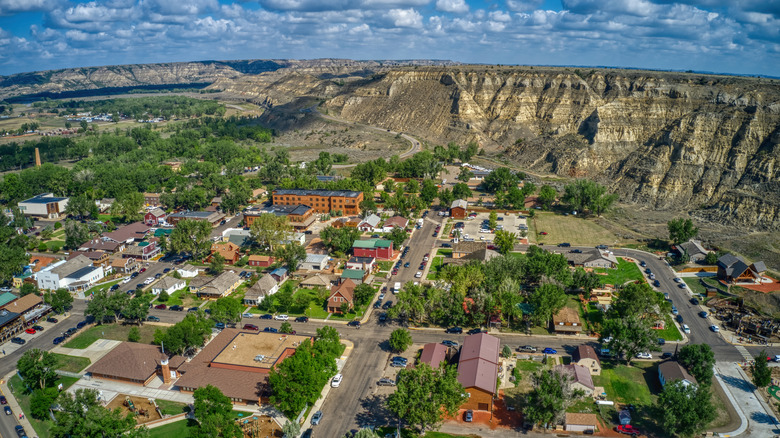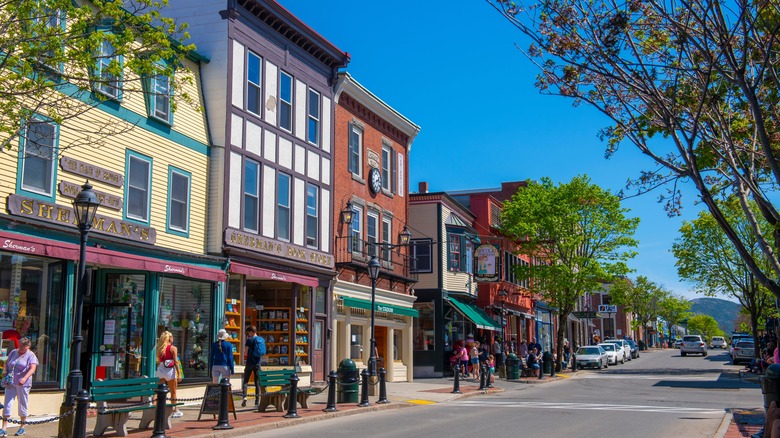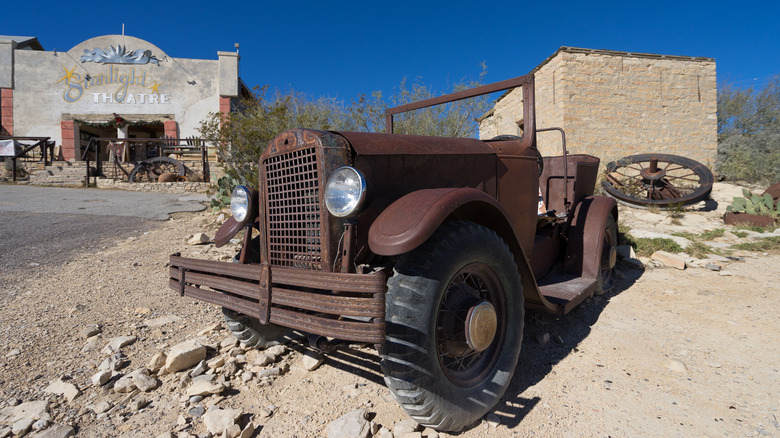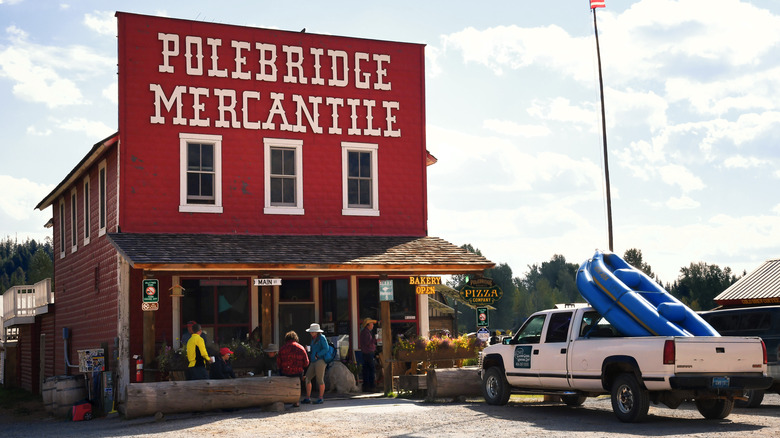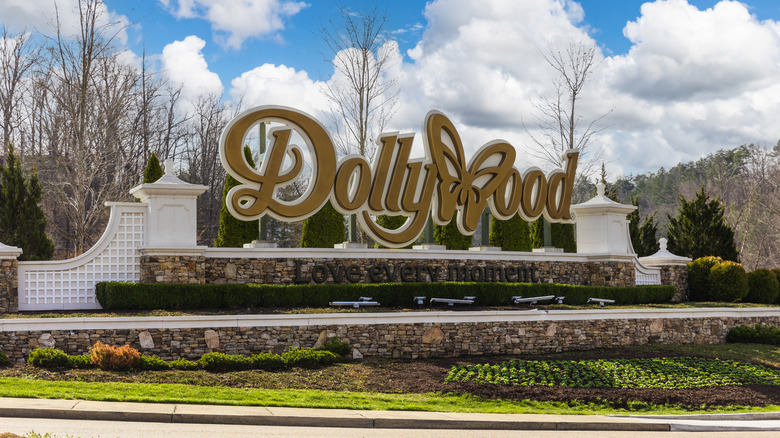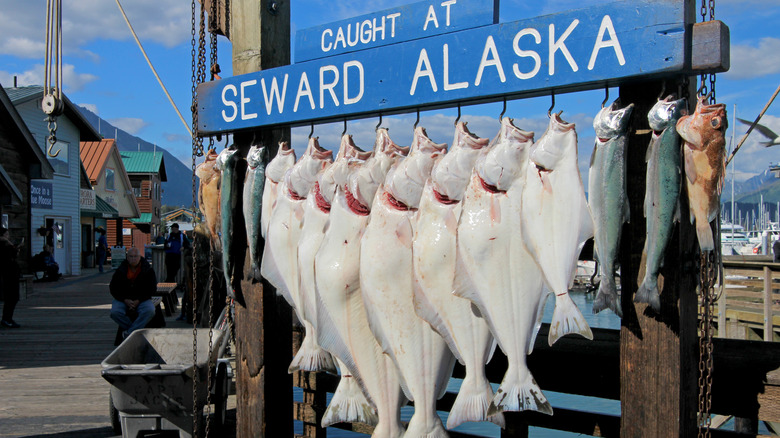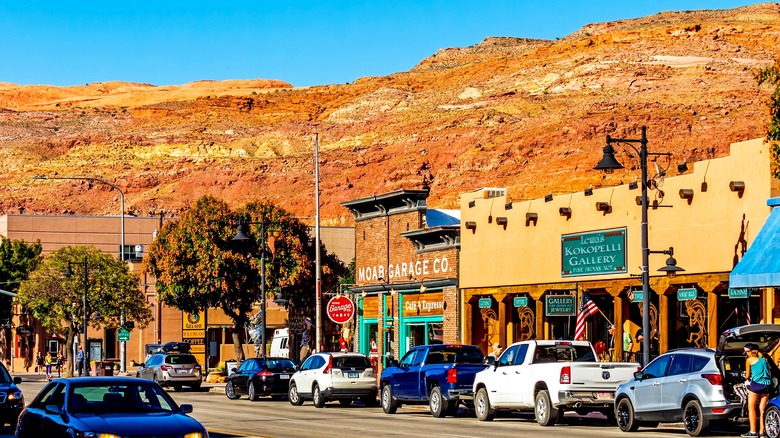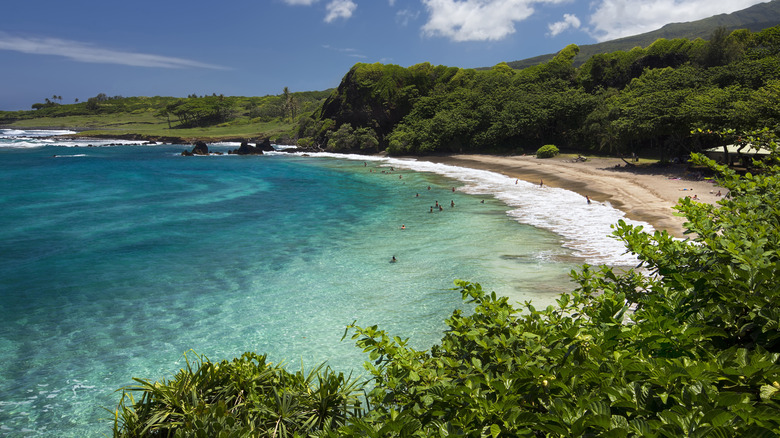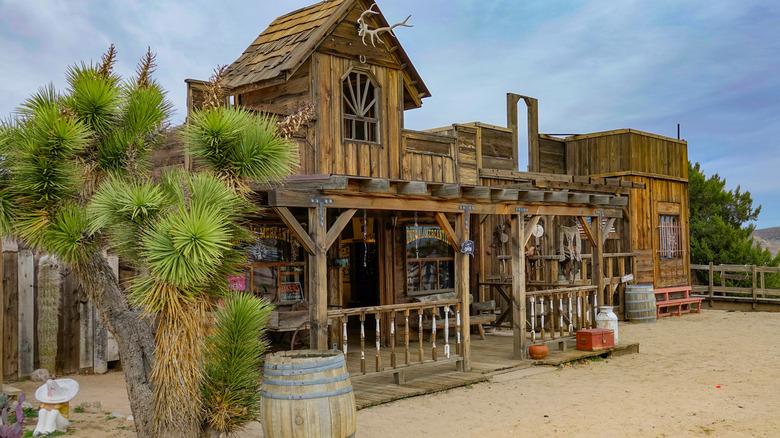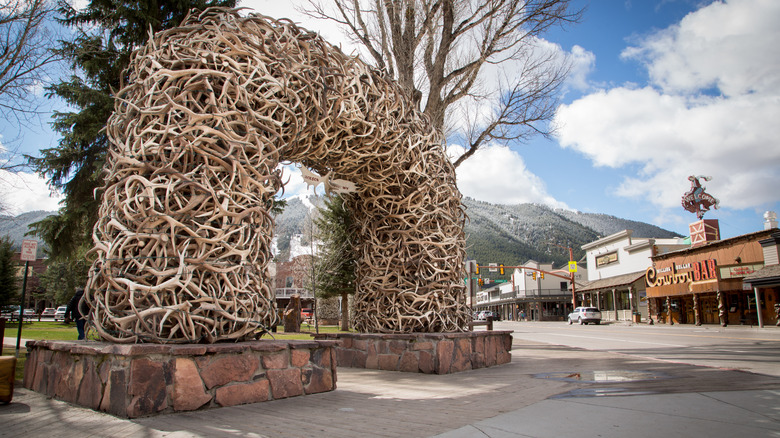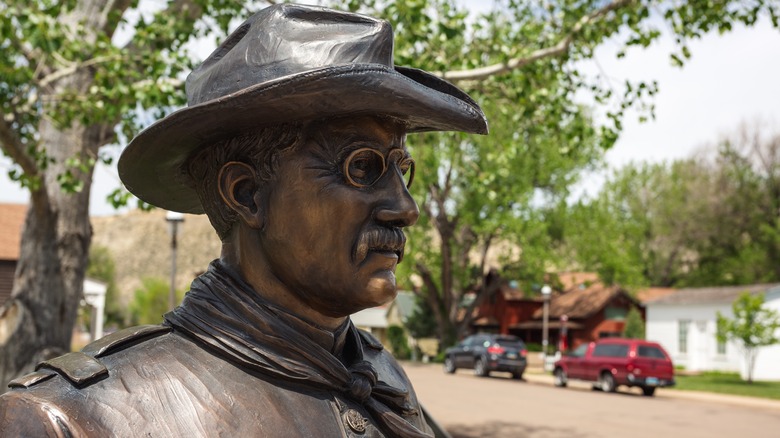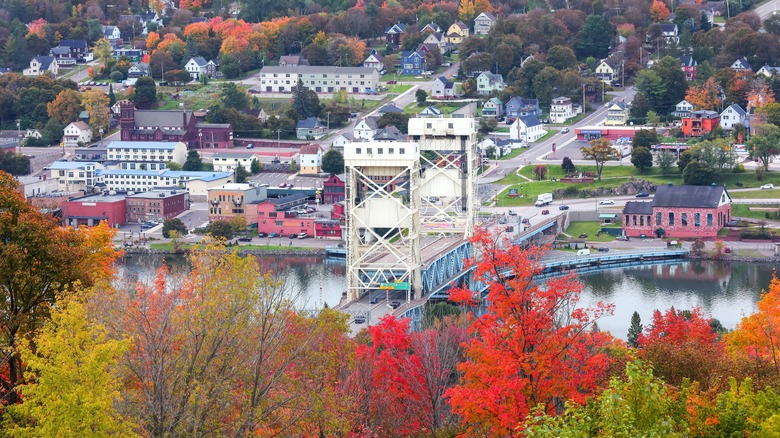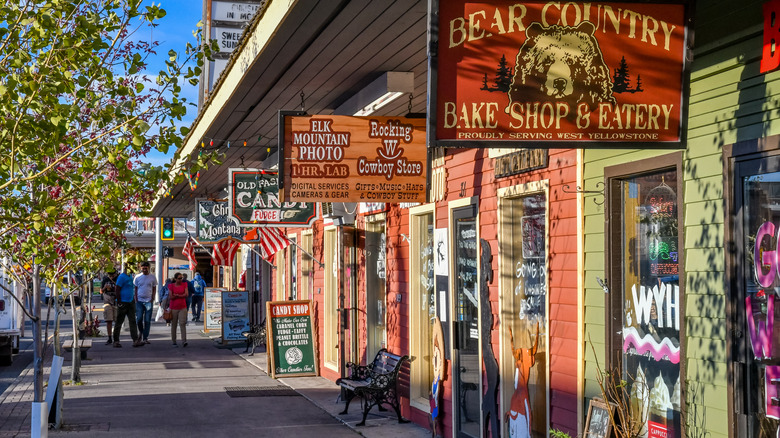Towns That Are Right Beside US National Parks And Full Of Unique Character
It's always great to enhance a national park visit by finding a fun town next to the park to use as a home base. From the partially abandoned mining town in Texas to a Montana town that is 100% off the grid to a California neighborhood that started as a fake Old West movie set, unique communities can be found near various national parks across the country.
A few of these national park neighbors are relatively well-known among travelers, such as the outdoorsy mountain towns of Moab, Utah and Jackson, Wyoming. The masses are still waiting to discover others, like Medora, North Dakota, a town next to Theodore Roosevelt National Park. It is home to the Cowboy Hall of Fame and historic attractions from the former president's visits to the area.
National parks near the ocean often have interesting towns nearby, so it's no coincidence that coastal towns in Alaska, Hawaii, and Maine all make the list as well. This article was created largely from personal experience, as we've traveled all over the country and visited each place on this list. Not every national park has an interesting town next door, but the dozen towns here have sufficient character, history, and natural beauty to make them worth visiting.
Bar Harbor, Maine (Acadia National Park)
Few national parks can claim to have a bustling business district less than 5 minutes away from its entrance. However, visitors to Maine's Acadia National Park are fortunate to have the neighboring town of Bar Harbor. A community of just over 5,000 residents, Bar Harbor has a walkable downtown full of cafés, shops, and B&Bs. It's a common summer vacation destination for folks in New England, as reflected by the fairly high lodging prices and the congested streets during summer weekends.
Bar Harbor has several notable restaurants, many of which serve up the seafood dishes that you'd expect from a coastal community. Some national parks are so far away from nearby towns that you have to pack your own meals. Here, it's possible to do some hiking or sightseeing in Acadia, then drive a few minutes to Bar Harbor to grab a lobster roll for lunch before returning to the park for more afternoon fun.
Whale-watching cruises are a popular activity from Bar Harbor, but many visitors prefer to spend most of their time in the national park itself. Acadia's highlights include Cadillac Mountain, the highest point on the eastern seaboard and one of the first places in the U.S. where the sunrise is visible each morning. There is also Thunder Hole, a cove where waves frequently slam into a rocky cavern, creating a thunderous noise.
Terlingua, Texas (Big Bend National Park)
Just 8 miles from the western edge of Big Bend National Park, Terlingua is often referred to as a ghost town because it has several abandoned buildings from its days as a mining community about 100 years ago. However, it's not a true ghost town. The small town remains active, with an artsy vibe and a few businesses serving Big Bend visitors.
Terlingua definitely leans into its reputation as a ghost town. The ruins of the old mining buildings are still visible on the hillside, and visitors can explore a few abandoned structures and a cemetery from 1902. Skeletons are a common part of the funky art pieces in town, like the skeleton riding a motorcycle near the "Welcome to Terlingua" sign. A rusted, abandoned classic car sits purposefully in front of the Starlight Theatre. This former movie center now serves as a restaurant with Mexican and Texas-inspired dishes and frequent live band performances.
Terlingua was the site of the first chili cookoff in the world back in 1967. Today, its annual November chili cookoff draws more than 10,000 people to the tiny town. The town also has taquerias, pizza restaurants, and a small number of hotels, guesthouses, and campgrounds.
Polebridge, Montana (Glacier National Park)
Imagine a U.S. town that is still off the electrical grid in 2024. That's Polebridge, Montana. Located near the northwest entrance of Glacier National Park, Polebridge is a unique town that gets all its power from solar panels and generators. Cell service is nonexistent, and there's not even a paved road –- it's one long, gravel road into Polebridge and onto the federal park entrance. Traveling to this tiny town definitely feels like returning to an earlier era. Like the entire Glacier National Park area, Polebridge offers incredible scenery, with mountains, rivers, and forests providing great hiking, biking, and kayaking opportunities. This town is one of the best-kept travel secrets in the state of Montana.
If you plan to visit the North Fork section of Glacier National Park to see attractions like Bowman Lake, do not drive through town without stopping at the Polebridge Mercantile. The "Merc" is known for its bakery, specifically the huckleberry bear claw pastries. The rest of what could be considered Polebridge's small business district consists of the Northern Lights Saloon, a hostel, and a few cabins that park visitors can rent (book early!)
Pigeon Forge, Tennessee (Great Smoky Mountains National Park)
From Gatlinburg to Sevierville, a lot of towns around the Smoky Mountains attract families with fun and offbeat attractions. Pigeon Forge deserves special attention because it's the home of Dollywood, the theme park created by country music legend and national treasure Dolly Parton. Dolly was born in Sevierville, but she became a part of the fabric of Pigeon Forge when Dollywood opened in 1986. The park features all the thrill rides and coasters you'd expect from a major amusement park, and Parton even makes appearances from time to time. Another Dolly-related Pigeon Forge point of interest is Dolly Parton's Dixie Stampede, a dinner show with an elaborate performance featuring more than 30 horses.
Imagine any family-friendly attraction, and Pigeon Forge probably has it: go-karts, mini golf, a water park, zip lines, trampolines, a Hollywood wax museum, and a Ripley's aquarium. The town also has an entertainment complex called The Island in Pigeon Forge, with roller coasters, a Ferris wheel, laser tag, an escape room, retail shops, and an arcade. The majority of attractions in Pigeon Forge are unabashedly touristy and offer kid-friendly experiences. Those visiting the area without children can stop by Pigeon Forge's breweries and distilleries or try whitewater rafting on the Pigeon River.
Seward, Alaska (Kenai Fjords National Park)
Seward is a quintessential port city in Alaska. Tourists can easily visit Seward from Anchorage by car or by riding the Alaska Railroad, which has a depot in Seward. Here, it's all about the sea, with recreational activities like kayaking, fishing, and boating. Seward is a town where it's worthwhile to just walk around and take in the sights. You can scan the skies and treetops for bald eagles. Visit the Seward Boat Harbor and watch the vessels come in with their catches from their daily fishing expeditions. Stroll through Waterfront Park and enjoy the views of the mountains across the bay.
Thousands of visitors use Seward as the gateway to Kenai Fjords National Park, which is mostly accessible via the water. Day cruises take patrons into the waters of Resurrection Bay to view orcas, humpbacks, and sometimes beluga and gray whales. These cruises usually provide a chance to see one of the park's massive glaciers up close where they meet the water. Another option is to drive to Exit Glacier, the only glacier in the national park accessible by car.
Hikers can find the Mount Marathon Trailhead right in town. The 4-mile trek gains quite a bit of elevation as it goes up the mountain. Be prepared to potentially encounter mountain goats, moose, and bears, which have all been seen near the trail. The Alaska SeaLife Center gives guests a chance to see all sorts of aquatic wildlife, including sea lions, octopuses, and puffins.
Moab, Utah (Arches National Park)
Moab is a popular city of 5,300 people renowned for its canyons, red rock formations, and other natural features. Moab sits at the doorstep of Arches National Park and is within a few hours' drive of Utah's four other national parks: Canyonlands, Capitol Reef, Bryce Canyon, and Zion. As a destination known mostly for outdoor adventure, Moab offers different experiences depending on the season.
Spring provides comfortable temperatures –- usually around 70 degrees Fahrenheit — and opportunities to see desert wildflowers blooming. The sweltering days of summer are best for early-morning hikes, water activities on the Colorado River, and observing the stars under some of the darkest night skies in the country. Autumn sees perfect weather for hiking the higher-elevation trails that have lost their snow cover. And winter brings another level of beauty as snow covers the rocks and mountain trails.
Moab has a cultural side as well. The Moab Arts Festival in May showcases artists in disciplines ranging from photography to sculpture. Similarly, the Moab Folk Festival in November features nationally and locally known singer-songwriters for three days.
Hana, Hawaii (Haleakala National Park)
Hana lies outside the southeastern edge of Haleakala National Park on the island of Maui. This is the town at the end of the Road to Hana, Hawaii's most famous road trip through coastal rainforest areas. The 52-mile drive is noteworthy for its dozens of one-lane bridges, roadside waterfalls, and ocean views. The Road to Hana is often considered one of the most scenic drives in America, as it alternates between hugging the coastline and meandering through more forested sections.
Since the drive takes more than two hours due to the heavy car traffic and the constantly winding roads, travelers who drive the Road to Hana typically spend at least one night in the town of Hana itself. Hana is a very small town, with just a few restaurants and shops. The Hana Cultural Center and Museum (temporarily closed at the time of publication) and Hamoa Beach are some of the attractions in the town.
Other highlights near the town include the Hana Lava Tube and Wai'anapanapa State Park, with its black sand beaches and walking trails. From Hana, visitors can take a short drive down to Haleakala National Park to see the more tropical Kipahulu District portion of the park that most visitors never get a chance to see.
Pioneertown, California (Joshua Tree National Park)
Located adjacent to the national park, the town of Joshua Tree, California, is one of the most artsy places in the desert. It's full of galleries and unique art installations, such as the Noah Purifoy Desert Art Museum and the Crochet Museum. The most unique town in the Joshua Tree area is found 12 miles west, in Pioneertown. This desert neighborhood was created in the 1940s strictly as an Old West movie set. Actors and singers like Roy Rogers and Gene Autry were among the superstars who filmed movies and TV shows here. The old buildings remain, filled with saloons, general stores, and gift shops that serve real customers.
The Pioneertown Film Museum has a collection of photos depicting many of the town's noteworthy moments in cinema. Though the 1950s were the peak era for filming in Pioneertown, video projects still take place today, including recent music videos by Ice Cube and Cyndi Lauper. Tourists who walk down Mane Street will feel they've been transported into an Old West movie. The vehicle-free road has a sign that reads, "Hoof 'n' foot only," noting that Mane Street is strictly for pedestrians and horse riders. Book a room at the Pioneertown Motel, and spend your evening at the lively BBQ joint Pappy + Harriet's, which has been serving up brews and bites for more than 40 years while providing live music several nights a week.
Jackson, Wyoming (Grand Teton National Park)
The mountain town of Jackson is more than 6,000 feet in elevation and is a short drive from Grand Teton National Park in Wyoming. Jackson has three major ski areas, including Jackson Hole Mountain Resort, which Forbes has repeatedly named the top ski resort in the country. Jackson is fun to explore during the summer months, as well. Grab a pint at one of the cowboy bars in town, join a weekly art gallery walk, or watch a bucking bronco competition at the Jackson Hole Rodeo, open from Memorial Day to Labor Day. The Jackson Hole Center for the Arts hosts rock bands, comedians, and theater performances year-round.
Wildlife is a big part of Jackson's culture. Walking around Jackson, you'll encounter a series of elk antler arches on the sidewalk; each comprises more than 2,000 antlers. The National Elk Refuge offers 24,000 acres of protected land, where elk typically live from December to April. The National Museum of Wildlife Art is a fascinating facility focusing on paintings and photography related to the natural world. The museum features work by emerging local artists, as well as big names like Warhol and Picasso.
Medora, North Dakota (Theodore Roosevelt National Park)
"I never would have been president if it had not been for my experiences in North Dakota," Theodore Roosevelt once said, according to the National Park Service. The future commander-in-chief arrived here by train as a young man in 1883 to hunt buffalo. He fell in love with the rugged country, invested in a ranch, then built another, and returned to the area many times over the years.
Today, the town of Medora borders the national park that bears his name. A statue of Roosevelt stands at the corner of Broadway and 3rd Street. Many of the gift shops and general stores in the walkable town still have an Old West feel. The North Dakota Cowboy Hall of Fame provides an experience you won't find in any other national park town. Explore exhibits about rodeo, ranching, and the Native American communities who lived here. Another cultural point of interest is the Chateau de Mores State Historic Site, a home built in the 1880s as a hunting lodge now serving as a history museum.
Visitors can stay at one of the inns or campgrounds and explore the town before heading into the park. The section of Roosevelt National Park known as the Elkhorn Ranch Unit houses the land where the former president's ranch once stood. The park is also known for uncommon wildlife, such as prairie dogs, bison, and rattlesnakes, and it's one of the few places in the U.S. to see wild horses.
Houghton, Michigan (Isle Royale National Park)
Isle Royale is an isolated national park in the middle of Lake Superior near the Canadian border. Most visitors reach the island via ferry from one of three locations: Grand Portage in Minnesota, Houghton, Michigan, or Copper Harbor in the Upper Peninsula of Michigan. Home to more than 7,000 residents, Houghton has an extensive mining history that visitors can explore. Operated by the National Park Service, Keweenaw National Historical Park is the place to learn the history of both Native Americans and immigrant settlers mining copper in the area.
The A.E. Seaman Mineral Museum on the Michigan Tech campus houses a collection of minerals from the Great Lakes area, including the Guinness World Record holder for the largest piece of copper found in Lake Superior. Houghton has hosted a popular Winter Carnival every February for more than a century. The four-day event includes snow statues and ice sculpture building. During the summer, Bridgefest is an annual event celebrating the towering Portage Lake Lift Bridge that connects Houghton with Hancock. The festival features games, a classic car show, a parade, and live music.
West Yellowstone, Montana (Yellowstone National Park)
Yellowstone National Park has five main entrances, and the most popular passes through the town of West Yellowstone. Much of the town's culture is based around the national park. If you didn't have the good fortune to see grizzly bears and wolves in the wild in Yellowstone, observe them in a safe environment at the Grizzly and Wolf Discovery Center. The bears were considered "nuisance bears" for being too aggressive or destructive and were brought here rather than being euthanized.
Then there's the Museum of the Yellowstone. Open from May to October, the museum features movies and exhibits about various aspects of the park, from its wildlife to natural disasters like earthquakes and fires that have shaped Yellowstone through the decades. Head to Hebgen Lake to paddleboard or kayak for outdoor fun or just watch the sunset. Other attractions in the town include the Wild West Yellowstone Rodeo and the Playmill Theatre, which has been presenting musical and dramatic performances since 1964.
